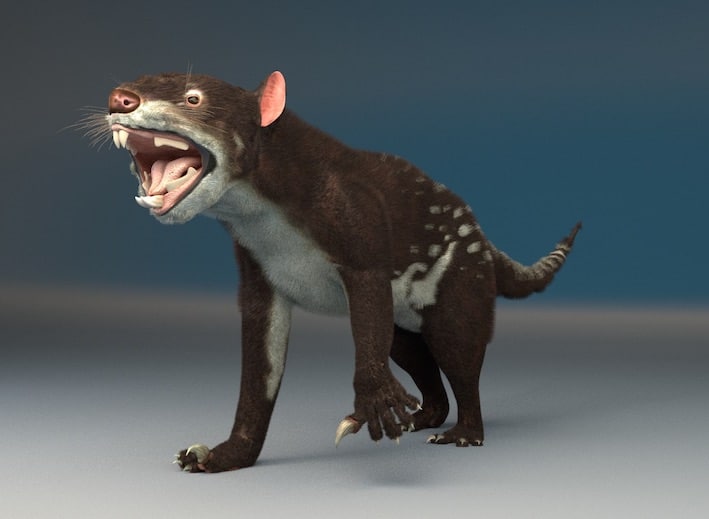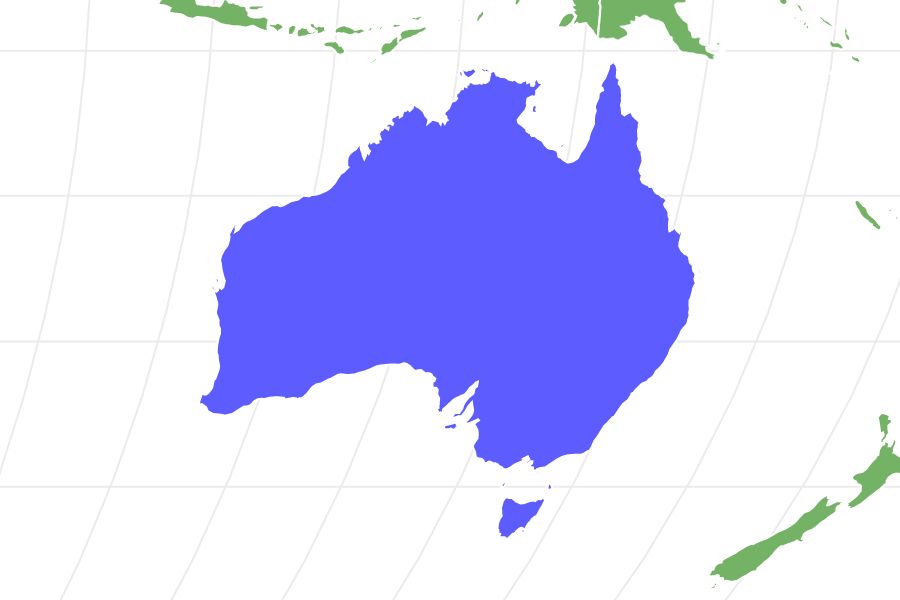Thylacoleo carnifex was the largest carnivorous mammal in Australia
Advertisement
Thylacoleo carnifex Scientific Classification
- Kingdom
- Animalia
- Phylum
- Chordata
- Class
- Mammalia
- Order
- Diprotodontia
- Family
- Thylacoleonidae
- Genus
- Thylacoleo
- Scientific Name
- Thylacoleo carnifex
Read our Complete Guide to Classification of Animals.
Thylacoleo carnifex Conservation Status
Thylacoleo carnifex Facts
- Prey
- Diprotodon and giant kangaroos
- Main Prey
- Diprotodon
- Fun Fact
- Thylacoleo carnifex was the largest carnivorous mammal in Australia
- Biggest Threat
- Climate change, humans
- Most Distinctive Feature
- Enlarged cheek teeth
- Distinctive Feature
- Enlarged thumb claws for disemboweling prey.
- Other Name(s)
- Marsupial lion
- Habitat
- Dry, open forest areas
- Diet
- Carnivore
- Type
- Marsupial lion
- Location
- Australia
Thylacoleo carnifex Physical Characteristics
- Weight
- 282–362 pounds
- Height
- 30 inches
- Length
- 59 inches
- Venomous
- No
- Aggression
- High
View all of the Thylacoleo carnifex images!
Thylacoleo carnifex is an extinct species of carnivorous marsupials that once lived in Australia. This species existed from the Late Pliocene to the Late Pleistocene Epoch (from two million years ago until about 46,000 years ago). Despite its similarities with modern-day lions in size and appearance, Thylacoleo carnifex was a marsupial (a pouched mammal similar to kangaroos). Thylacoleo carnifex was the largest carnivore in Australia and was an apex predator.
Description and Size
Thylacoleo carnifex is a species of carnivorous marsupials native to Australia. The genus “Thylacoleo” means pouch lions, a fitting name because they were marsupials (mammals that give birth to premature young in pouches) rather than actual lions. This species was the last and largest member of the Thylacoleonidae family of marsupial lions. Members of this family are called marsupial lions because they resemble regular placental lions and were large apex predators of their time. However, they’re not in any way related to the modern lion.
Thylacoleo carnifex is one of the three species in the Thylacoleo genus. With an average weight of 223–287 pounds (around the same weight as an adult lioness), this carnivore was one of Australia’s largest carnivorous mammals. Individuals in this species were as much as 30 inches tall at the shoulders and about 59 inches long from head to tail.
A prominent feature of the Thylacoleo carnifex was its enlarged cheek teeth. Their third molars were modified to form long shearing blades, which completely took over the position of the posterior molar teeth or reduced their size. Unlike other carnivorous mammals that tend to have canine teeth, this animal had large serrated upper incisors and horizontally oriented lower incisors.
Thylacoleo carnifex also had enlarged thumb claws for disemboweling prey. The claws were retractable like that of modern cats. Its limb proportion and muscle mass distribution show how powerful this animal might have been. The limbs were adapted for climbing, but the animal was probably not very fast.

The
Thylacoleo carnifex
had enlarged, retractable thumb claws for disemboweling prey.
©Jose manuel canete/CCBYSA4.0 – License
Diet—What Did the Thylacoleo carnifex Eat?
A first look at the cranial bones of the Thylacoleo carnifex would instantly suggest a carnivorous diet. However, not all scientists agreed with this claim in the early days of its discovery. Many point to the animal’s ancestry and relationship with known herbivores like koalas and other marsupials as a possible explanation for an herbivorous diet. Some early scientists also described it as a scavenger or bone crusher.
The more prevalent theory today is that this animal was a carnivore. Thylacoleo carnifex had no grinding teeth, which would have made a plant-based diet unlikely. In fact, many scientists today consider the Thylacoleo carnifex as the most specialized mammalian carnivore of all time. It was an apex predator with blade-like teeth designed to slice through flesh, powerful forearms, and large, retractable claws.
Another interesting feature is the massive bite force of this carnivore, which is said to be the most powerful of any mammalian predator ever. Its bite strength allowed it to bring down prey much larger than itself without any problem. T. carnifex had a bite force comparable to that of an African lion, even though it was smaller in size. The marsupial lion’s diet may have included big game like the Diprotodon and giant kangaroos that were quite abundant in Australia during that time.
Habitat—When and Where Did the Thylacoleo carnifex Live?
Thylacoleo carnifex lived across Australia, with a range that covered almost the entire continent. It was alive for almost two million years, starting from the Late Pliocene Epoch to the Late Pleistocene. Most of the sites where fossils of this carnivore have been found were dry open forest areas during the Pleistocene.
Threats and Predators
Thylacoleo carnifex was the biggest carnivore in its time, and it was likely an apex predator in its native territory. While this massive beast probably had no predators, it lived during a period of great environmental change. Climate change was a major threat to their existence, and it most likely contributed to their decline. Changes in environmental factors led to the extinction of the megafauna of Australia, which they preyed on. Humans were also a major threat when they came onto the scene towards the end of the Pleistocene.
Discoveries and Fossils
Sir Thomas Mitchell found the first fossil of Thylacoleo carnifex in the early 1830s in the Wellington Valley region (South Wales). However, he did not recognize them or name them right away. A fragmentary specimen was later found near lake Colongulac by Willian Adeney. Richard Owen published a description based on this find. For several years later (up to a century after the first discovery), paleontologists could only find skull, jaw, and teeth fragments. The first nearly complete skeleton was found in 1966. Only a foot and the tail were missing in this well-preserved specimen.
In 2002, scientists uncovered another set of well-preserved fossils. The set included up to eight complete sets of bones. Scientists theorized that they probably fell through into a limestone cave under Nullarbor Plain. Some of the individuals died in the fall, and the few that survived died of starvation. Scientists have also found rock art and trace fossils (scratch marks) of this carnivore.
Extinction—When Did the Thylacoleo carnifex Die Out?
Thylacoleo carnifex went extinct about 45,000 years ago, along with the rest of Australia’s megafauna. Climate change was probably the main reason for this extinction event. But some experts also point to human activities as a possible contributory factor. It is believed that the newly arrived humans on the Australian continent altered the local ecosystem through their human and bush-burning activities. Interestingly, the disappearance of the Thylacoleo carnifex has changed the natural ecosystem of Australia since no other large carnivore evolved to take its place.
Similar Animals to the Thylacoleo carnifex
Similar animals to the Thylacoleo carnifex include:
- Thylacinus megiriani — This was another marsupial predator native to Australia. It looked like a dog but had a longer snout. Unlike the marsupial lion, this carnivore lived in a forest ecosystem in northern Australia.
- Panthera spelaea — Also called the Eurasian cave lion or steppe lion, this was a species of lion that evolved in Europe during the Middle and Late Pleistocene.
- Protemnodon: This is an extinct genus of a giant kangaroo that lived in Australia during the Pliocene and Pleistocene.
Related Animals
View all 133 animals that start with TThylacoleo carnifex FAQs (Frequently Asked Questions)
When was the Thylacoleo carnifex alive?
Thylacoleo carnifex was alive from the Late Pliocene to the Late Pleistocene epochs. This period was about two million years ago. The animal went extinct during Australia’s megafauna extinction event roughly 46,000 years ago.
How big was the Thylacoleo carnifex?
Thylacoleo carnifex was one of the largest predators that lived in Australia. It weighed between 282 and 362 pounds on average and was probably as tall as 30 inches, with a body length of 59 inches from head to tail.
Could Thylacoleo carnifex still exist?
Thylacoleo carnifex is an extinct marsupial lion. It went extinct along with the rest of Australia’s megafauna. It’s unlikely that the Thylacoleo carnifex survived or evolved into another carnivore.
Did Thylacoleo carnifex climb trees?
Thylacoleo carnifex had strong limbs, which it could have used to climb trees. Researchers recently uncovered new anatomical evidence that it did climb trees. Also, it suggests that it was an ambush predator that probably attacked prey from trees since it wasn’t adapted for speed.
Thank you for reading! Have some feedback for us? Contact the AZ Animals editorial team.
Sources
- Australian museum, Available here: https://australian.museum/learn/animals/mammals/thylacoleo-carnifex/
- Wikipedia, Available here: https://en.wikipedia.org/wiki/Thylacoleo
- WA Museum, Available here: https://museum.wa.gov.au/research/collections/earth-and-planetary-sciences/fossil-collection/thylacoleo-carnifex

















